
You know you're on the fringes of China when you see lots of land and few people on it. Such is Qinghai, lonely buffer province between "China proper" and the exotic realms of Tibet, Xinjiang, and Mongolia. But its relegated status belies a fascinating history, and a culture unmatched for diversity anywhere else in the Middle Kingdom [at least ethnographically]. Its capital, Xining, is the only city in Qinghai with over a million people. For the cosmopolite, Xining is a stop-over on the way to Lhasa. For the urban frontiersman, it is a holdout against global conformity, a perfect jumping off point into a long simmering stew of cultural richness and nature at her most starkly magnificent.
Vital Stats
350 square kilometers of fertile Huangshui River valley, on the edge of the Tibet-Qinghai tableau.
Just over two million souls in the greater area, with a per capita GDP of 16,000RMB.
Arid high - plateau climate, with an altitude of 2200 meters downtown, and corresponding big swings in daily temperature. Cool in the summer, frigid all winter.
Both an ancient and a modern trade route stop between north China and Tibet.
Economic paradigm of the far-flung second-tier Chinese city struggling to develop in line with coastal metropoles. Livestock and flower entrepreneurs should click here . Fans of underdog Tech Development Zones click here.
Out of Tibet's Shadow
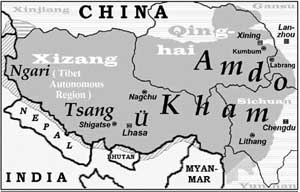
If one were to take a map and make a triangle by connecting Lhasa, Urumqi, and Hohhot, then Xining would be smack in the middle of its base. Thus it should come as no surprise that there is as much Tibetan, Muslim, and Mongolian influence permeating the city as there is Han Chinese. In fact, Qinghai once formed the bulk of a vast kingdom known as Amdo, which at times was an apolitical province of Tibet, but always a baffling mélange of different tribes and peoples.
However, Xining from before the Common Era served the Han Dynasty as a fortified outpost from which to repel invasion and launch raids, or strategic offensives, if you like. Thus its fitness for provincial capital status, assigned during the late Qing Dynasty, not after the Communist takeover, as is commonly believed.
In its PRC incarnation, Xining atrophied into a backwater, the kind of place young city slickers in need of re-education were sent during the Cultural Revolution. But what's half a century or so of stagnation, in a city hard by the headwaters of China's life blood, the Yellow River? Under Qinhai's brilliant blue skies, as yet untroubled by industrial belching, one finds it hard to focus on past economic performance, wondering instead what lies over the next ridge of green hills.
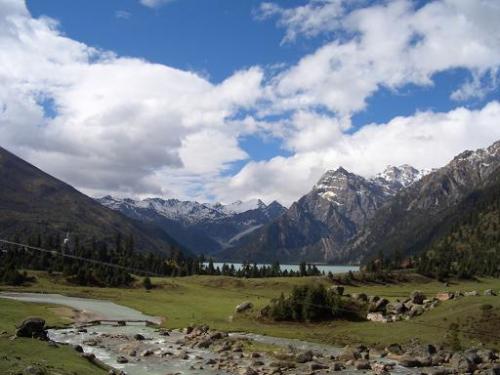
A river runs through it...
Not to give the impression that Xining itself twinkles with beauty. Architecturally, it is a place where social realism did its best to cover up centuries of hardscrabble urban planning, or lack thereof. As in all such Chinese cities, the result is a sprawling mess. The city center, of course, is the usual tribute to modern China's progress, but gives way to crumbling apartment blocks and peddler markets much more rapidly than most cities back east.
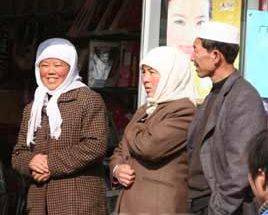 People-watching should surely make up for the lack of architectural inspiration (until one gets to Qinghai's monasteries and temples - see below). Qinghai is home to 37 minority people. Hui and Salar Muslims, Tu, Tibetan, and Mongol Buddhists, as well as the ever-thriving Han throng the streets of Xining, a never-ending parade of facial and linguistic diversity, although a Mandarin dialect much akin to Gansu's prevails.
People-watching should surely make up for the lack of architectural inspiration (until one gets to Qinghai's monasteries and temples - see below). Qinghai is home to 37 minority people. Hui and Salar Muslims, Tu, Tibetan, and Mongol Buddhists, as well as the ever-thriving Han throng the streets of Xining, a never-ending parade of facial and linguistic diversity, although a Mandarin dialect much akin to Gansu's prevails.
For all but the most adventurous, cross-cultural interaction occurs at the consumer points of eating and shopping. Travelers still unused to Chinese culinary experiences will be aided by Xining's sharp air, a real appetite booster. An appreciation for grilled lamb will help, though, as its aroma is never far away. The sprawling markets downtown have the best places to eat authentically; kebabs, spicy noodles, mutton hotpot, and local favorite zasui soup, made with ox and sheep entrails, await those brave enough to get on the outside of some real Qinghai culture. Covered market Shuijing Xiang is an ideal spot, as are the many side streets around Da Shizi. The Daxin Jie night market is perfect for the puckish and jet-lagged who still crave stimulation.
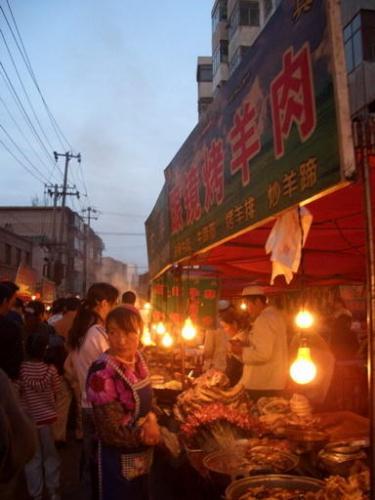
Up-market but still authentic dining can be had at Zangjia Ju, a Tibetan restaurant on Changjiang Lu with evening shows. Hei Zhangpeng (The Black Tent), on Wenhua Jie, offers Tibetan, Nepali, and Indian dishes. Those who must revert to Western may find sanctuary at the Boronias Coffee Shop (two locations: Wusi Dajie and Xi Dajie), and a newly-opened Italian restaurant, also on Wusi Dajie. The incorrigible may be sated at one of the half-dozen Dicos, the bizarre McDonald's rip-off chain, peppering the city.
As to shopping, Tibetan peddlers flog their wares in all the proletarian areas of Xining, but their mecca is the Tibetan Market across from the bus station on Jianguo Dajie. The market also features the Qinghai Tibetan and Mongolian Tent Factory, where one can purchase a custom portable dwelling, West China style. Nonetheless, The Shuijing Xiang Market remains Xining's most popular, as reminiscent of the Silk Road as anything one can find south of Kashgar.
The average foreigner in Xining is in transit to Lhasa. Links to good hostels and hotels are here under ‘Xining Hotels'. For A hard sleeper ticket to Lhasa costs 523 RMB, and still requires a Tibet Travel Permit. It's a 26-hour odyssey on the N917. Xining's air-ticket hotline (0971 813 3333) is the best bet for planing it, but requires Mandarin.
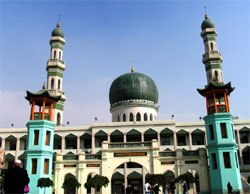 Before that average foreigner leaves, however, she ought to take in the Dong Guan Mosque (#30 Dongguan Dajie, 10 RMB), especially on a Friday afternoon when literally tens of thousands pour in to praise Allah. South Mountain Park (Nan Shan Gongyuan) rewards a good stretch of the legs with a panoramic view of the city and a Tibetan Temple at the summit. The Qinghai Provincial Museum (Qinghai Sheng Bowuguan,, 58 Xiguan Dajie, 9:30am-4pm Tues-Sun) focuses primarily on the region's Tibetan culture, but boasts impressive Stone Age and Silk Road Era exhibits.
Before that average foreigner leaves, however, she ought to take in the Dong Guan Mosque (#30 Dongguan Dajie, 10 RMB), especially on a Friday afternoon when literally tens of thousands pour in to praise Allah. South Mountain Park (Nan Shan Gongyuan) rewards a good stretch of the legs with a panoramic view of the city and a Tibetan Temple at the summit. The Qinghai Provincial Museum (Qinghai Sheng Bowuguan,, 58 Xiguan Dajie, 9:30am-4pm Tues-Sun) focuses primarily on the region's Tibetan culture, but boasts impressive Stone Age and Silk Road Era exhibits.
The dedicated China traveler will view Xining as her springboard into exploring Qinghai, so we'll close with some of its most fulfilling destinations.
Taer Si Temple
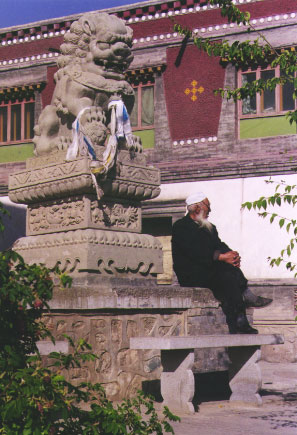
There are other monasteries in Qinghai more impressive in atmosphere and scenery, but none with more historical import. Taer Si is hallowed ground, the birthplace of Tsonghkapa, founder of Tibetan Buddhism's Yellow Hat Sect. Known as Kumbum in Tibetan, Taer Si features an eleven-meter stupa to mark the spot of Tsonghkapa's birth, hundreds of ornate human sculptures, and animals and landscapes carved from yak butter.
Qinghai Lake

China's largest lake, sacred to the Tibetans and Mongolians(who call it Kokonor), lies some 150 kilometers from Xining, and is historically regarded as the midway point between Tibet and Mongolia. Fittingly, this is where Mongolian leader Altan Khan made Sonam Gyatso the Dalai Lama.
The lake itself is a limpid marvel to behold, constantly shifting color to reflect the rarefied high-plain skies above. Ringing the lake are green mountains, and valleys filled with grazing sheep and cattle. Wheat and rapeseed crops abut the lake, making for a riot of color and fragrance in season. However, the main attraction is Niao Dao (Bird Island) on the lake's western shore, a breeding ground for sandpipers, cormorants, geese, and the endangered black-necked crane.
The best time to visit Qinghai Lake is between March and September, although it will be inaccessible after any outbreak of avian flu. It has yet to stop the ten - day, 1400 km international bike race held there each July.
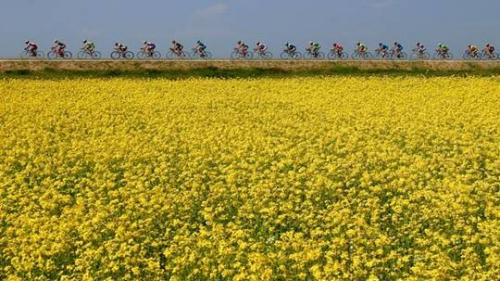
Ping an

Ping an is a forty-minute shuttle ride from Xining. Thirty kilometers southeast of Ping an lies the Village of Hongya, better known as Taktser and birthplace of the Dalai Lama. A childhood bed, family photos, and more are kept in a building identifiable by its large wooden gated tied with katags, white ceremonial scarves.
Rongwo Gonchen Gompa, Gomar Gompa & Wutong Monasteries
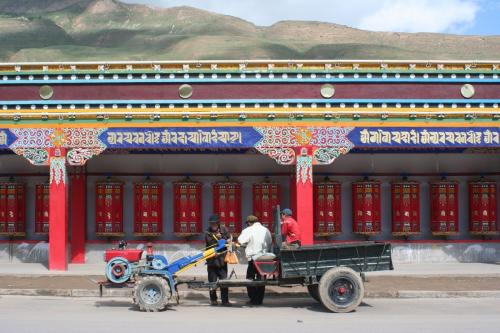
Rongwo Gonchen Gompa is a huge, rambling monastery located in Tongren (Repkong), a four-hour bus ride from Xining. Built in 1301, it is a maze of renovated chapels and monk residences. Wutong Si, ten kilometers outside of Tongren, is divided into two monasteries, the upper one considered by far the more impressive. Four hundred year old Gomar Gompa is a an invigorating walk across the valley from Wutong, and bears a decidedly medieval look. Tongren derives much distinction, however, as the ideal place to buy thangkas, traditional Tibetan paintings, and see them painted.
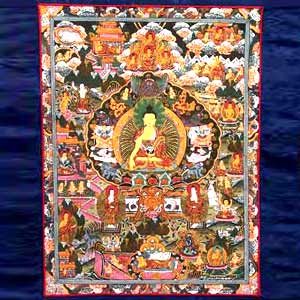
Mengda Nature Reserve

190 kilometers southeast of Xining, in the mountains just above the Yellow River, this reserve is known mainly for Heaven Lake, a body of water sacred to both the Salar Muslims and Tibetan Buddhists. The bus ride to Mengda is one of the most visually breathtaking to be had in China, and the nearby town of Jiezi is populated by the Salar, whose Turkic origins give the place a decidedly Central Asian feel.
Ernie's blog
Warning:The use of any news and articles published on eChinacities.com without written permission from eChinacities.com constitutes copyright infringement, and legal action can be taken.
All comments are subject to moderation by eChinacities.com staff. Because we wish to encourage healthy and productive dialogue we ask that all comments remain polite, free of profanity or name calling, and relevant to the original post and subsequent discussion. Comments will not be deleted because of the viewpoints they express, only if the mode of expression itself is inappropriate.
Please login to add a comment. Click here to login immediately.